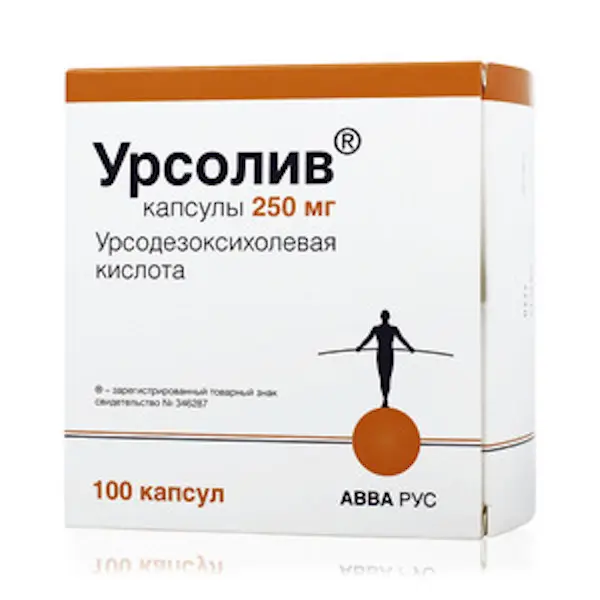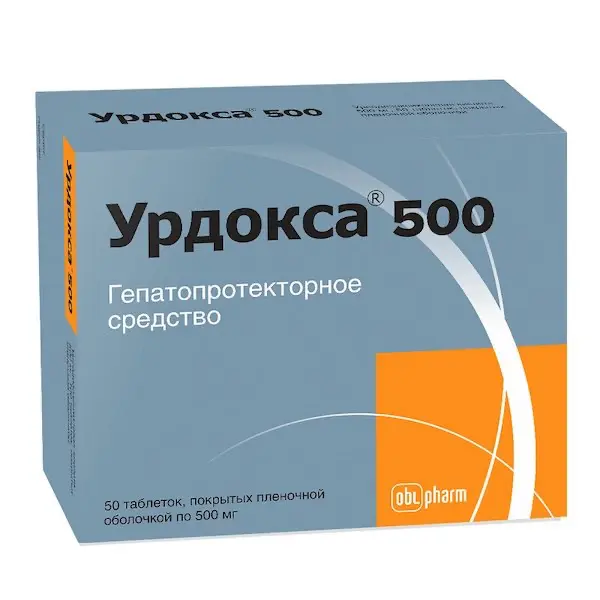Description
Ursoliv Pharmacodynamics
It has hepatoprotective, choleretic, cholestolytic, hypolipidemic, hypocholesterolemic and some immunomodulatory effects.
In in vitro studies it was shown that ursodeoxycholic acid (UDCA) has a direct protective effect on liver cells and reduces hepatotoxicity of hydrophobic salts of bile acids.
The main effects of UDCA on cholesterol metabolism include: reducing cholesterol secretion, reducing its intestinal absorption and stimulating the release of cholesterol from cholesterol stones into the bile. UDCA, by inhibiting HMK-CoA reductase, also has a moderate inhibitory effect on cholesterol synthesis in the liver. Increases the solubility of cholesterol in the biliary system. Causes partial or complete dissolution of cholesterol gallstones when administered enterally, reduces the saturation of bile with cholesterol.
Stimulates formation and excretion of bile, accelerates excretion of toxic bile acids through the intestines. When taking orally UDCA share in total bile acid pool increases significantly; UDCA competes with other bile acids during absorption in small intestine as well as during penetration through hepatocyte membrane, which leads to decrease in absorption of toxic bile acids in intestine and their entry into liver, preventing their cytopathogenic effect.
It reduces bile lithogenicity, increases concentration of bile acids in bile, causes intensification of gastric and pancreatic secretion, increases lipase activity and produces hypoglycemic effect.
It affects immunological reactions by reducing pathological expression of HLA I main histocompatibility complex antigens on hepatocytes and HLA II on cholangiocytes, suppresses interleukin 2 production, reduces the number of eosinophils.
Indications
– Dissolution of cholesterol gallstones;
– Biliary reflux gastritis;
– Primary biliary cirrhosis in the absence of signs of decompensation;
– Chronic hepatitis of various genesis;
– Primary sclerosing cholangitis;
– Cystic fibrosis (as part of complex therapy);
– Nonalcoholic steatohepatitis;
– Alcoholic liver disease;
– Biliary dyskinesia.
Contraindications
X-ray-positive (high in calcium) gallstones; impaired gallbladder contractility, obstruction of biliary tracts (blockage of common bile duct or vesicular duct), frequent episodes of gall cramps; acute inflammatory diseases of gallbladder and bile ducts; decompensated liver cirrhosis; severe hepatic and/or renal insufficiency, hypersensitivity to the drug components or other bile acids.
Pediatric population.
Unsuccessfully performed portoenterostomy or cases of absence of restoration of normal bile flow in children with biliary tract atresia.
Dosage and administration
- Inside. If it is difficult to swallow, the capsule may be opened and the contents taken with sufficient amount of liquid.
- The dissolution of cholesterol gallstones:
- The capsules are taken in the evening, before going to bed, with plenty of fluids. Approximately 10 mg per 1 kg of body weight daily, which corresponds to:
- 2 capsules of Ursoliv® in patients with a body weight of up to 60 kg;
- 3 capsules of Ursoliv® in patients weighing up to 80 kg;
- 4 capsules of Ursoliv® in patients with a body weight of up to 100 kg;
- 5 capsules of Ursoliv® in patients with body weight over 100 kg.
- Duration of treatment 6-12 months.
- For prevention of recurrent stone formation it is recommended to take the drug for several more months after dissolution of stones.
- Symptomatic treatment of primary biliary cirrhosis:
- Daily dose depends on body weight and is from 2 to 6 capsules (about 10 to 15 mg of ursodeoxycholic acid per 1 kg of body weight).
- The drug is taken with food, with plenty of liquid.
- The following regimen is recommended:
- Body weight Daily dose Morning Afternoon Evening
- 34-50 kg 2 capsules 1 – 1
- 51-65 kg 3 capsules 1 – 1
- 66-85 kg 4 capsules 1 1 2
- 86-110 kg 5 capsules 1 2
- Over 110 kg 6 capsules 2 2
- For the treatment of biliary reflux gastritis:
- 1 capsule once daily before bedtime.
- Course of treatment – from 10-14 days to 6 months, if necessary – up to 2 years.
- In chronic hepatitis of different genesis (toxic, medicinal, etc.), nonalcoholic fatty liver disease, including nonalcoholic steatohepatitis, alcoholic liver disease:
- The average daily dose is 10-15 mg/kg in 2-3 doses. Duration of therapy – 6-12 months or more.
- In primary sclerosing cholangitis, cystic fibrosis (cystic fibrosis):
- The average daily dose is 12-15 mg/kg; if necessary, the average daily dose may be increased to 20-30 mg/kg in 2-3 doses. Duration of therapy – from 6 months to several years.
- In biliary dyskinesia of hypokinetic type:
- The average daily dose is 10 mg/kg in 2 doses for 2 weeks to 2 months. If necessary, the course of treatment is recommended to be repeated.





